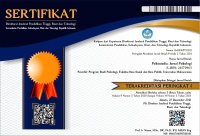Speeding Behavior Among Young Motorcyclists: The Role of Theory of Planned Behavior Variables and Willingness
Abstract
Speeding behavior is one of the factors that can cause traffic accidents. To date, empirical studies that examine psychological model in the context of speeding behavior among young motorcyclists in Indonesia are scarce. This study aims to examine the effect of the Theory of Planned Behavior (TPB) variables, namely, Intentions, Attitudes, Perceived Norms, and Perceived Behavioral Control, and Willingness as additional variables on the frequency of riding motorcycle over the speed limit among young motorcyclists in Ponorogo, East Java. This study used a quantitative-correlational design. The subjects of this study were young motorcyclist (16-23 years-old, N = 301) living in Ponorogo. Data collection was carried out using the Intention, attitude, perceived norm, and perceived behavioral control scale and the willingness scale. Data analysis was carried out using hierarchical multiple regression analysis using SPSS. The results showed that intention, perceived behavioral control, and willingness had a significant effect on the frequency of riding a motorcycle over the speed limit. In addition, attitudes, perceived norm, and perceived behavioral control significantly influenced intention to speed. Based on the above findings, it can be concluded that the Theory of Planned Behavior (TPB) and willingness variables have a significant influence on speeding behavior among young motorcyclists in Ponorogo, with which willingness has the largest influence.
Faktor yang dapat menyebabkan terjadinya kecelakaan lalu lintas. Sejauh ini, belum terdapat penelitian empiris yang menguji model teori Psikologi dalam konteks perilaku ngebut pada pengendara motor usia muda di Indonesia. Penelitian ini bertujuan untuk menguji pengaruh variabel Theory of Planned Behavior (TPB) yaitu, intensi, sikap, norma yang dirasakan, dan kontrol perilaku yang dirasakan, dan kesediaan sebagai variabel tambahan terhadap frekuensi berkendara sepeda motor melebihi batas kecepatan di kalangan premotor usia muda di Ponorogo, Jawa Timur. Penelitian ini menggunakan desain kuantitatif-korelasional. Subjek dalam penelitian ini adalah pengendara sepeda motor usia muda (16-23 tahun, N = 301) yang tinggal di Ponorogo. Pengumpulan data dilakukan menggunakan skala intensi, skala persepsi norma, skala persepsi kontrol perilaku dan skala kesediaan. Analisis data dilakukan menggunakan analisis regresi liniear bertingkat. Hasil penelitian menunjukkan bahwa intensi, persepsi kontrol perilaku, dan kesediaan berpengaruh signifikan terhadap frekuensi mengendarai motor melebihi batas kecepatan. Selain itu, sikap, persepsi norma, dan persepsi kontrol perilaku berpengaruh terhadap intensi untuk berkendara melebihi kecepatan. Berdasarkan temuan diatas, dapat disimpulkan bahwa variabel TPB dan kesediaan memiliki pengaruh yang signifikan perilaku ngebut di kalangan pengendara usia muda di Ponorogo, dimana kesediaan memiliki pengaruh yang paling besar.
Keywords
Full Text:
ENReferences
Ajzen, I. (2011). The theory of planned behaviour: reactions and reflections. Psychology & Health, 26(9), 1113–1127. https://doi.org/10.1080/08870446.2011.613995
Bazargan-Hejazi, S., Teruya, S., Pan, D., Lin, J., Gordon, D., Krochalk, P. C., & Bazargan, M. (2017). The theory of planned behavior (TPB) and texting while driving behavior in college students. Traffic Injury Prevention, 18(1), 56–62. https://doi.org/10.1080/15389588.2016.1172703
BPS-Statistics Indonesia. (2018). Land Transportation Statistics. https://www.bps.go.id/publication/2018/11/27/43cba6b697f03cc2b272dfb7/statistik-transportasi-darat-2017.html
Carey, R. N., Mcdermott, D. T., & Sarma, K. M. (2013). The Impact of Threat Appeals on Fear Arousal and Driver Behavior : A Meta-Analysis of Experimental Research 1990 – 2011. 8(5). https://doi.org/10.1371/journal.pone.0062821
Castanier, C., Deroche, T., & Woodman, T. (2013). Theory of planned behaviour and road violations: The moderating influence of perceived behavioural control. Transportation Research Part F: Traffic Psychology and Behaviour, 18(2013), 148–158. https://doi.org/10.1016/j.trf.2012.12.014
Cestac, J., Paran, F., & Delhomme, P. (2011). Young drivers’ sensation seeking, subjective norms, and perceived behavioral control and their roles in predicting speeding intention: How risk-taking motivations evolve with gender and driving experience. Safety Science, 49(3), 424–432. https://doi.org/10.1016/j.ssci.2010.10.007
Chorlton, K., Conner, M., & Jamson, S. (2012). Identifying the psychological determinants of risky riding: An application of an extended Theory of Planned Behaviour. Accident Analysis and Prevention, 49, 142–153. https://doi.org/10.1016/j.aap.2011.07.003
Chung, Y. S. (2015). Seemingly irrational driving behavior model: The effect of habit strength and anticipated affective reactions. Accident Analysis and Prevention, 82, 79–89. https://doi.org/10.1016/j.aap.2015.05.003
DPR-RI. (2009). Undang-undang Republik Indonesia Nomor 22 Tahun 2009 Tentang Lalu Lintas dan Angkutan Jalan. http://www.dpr.go.id/dokjdih/document/uu/UU_2009_22.pdf
Elliott, M. A. (2010). Predicting motorcyclists’ intentions to speed: Effects of selected cognitions from the theory of planned behaviour, self-identity and social identity. Accident Analysis and Prevention, 42(2), 718–725. https://doi.org/10.1016/j.aap.2009.10.021
Elliott, M. A., Armitage, C. J., & Baughan, C. J. (2007). Using the theory of planned behaviour to predict observed driving behaviour. British Journal of Social Psychology, 46(1), 69–90. https://doi.org/10.1348/014466605X90801
Elliott, M. A., Baughan, C. J., & Sexton, B. F. (2007). Errors and violations in relation to motorcyclists’ crash risk. Accident Analysis & Prevention, 39(3), 491–499. https://doi.org/10.1016/J.AAP.2006.08.012
Elliott, M. A., McCartan, R., Brewster, S. E., Coyle, D., Emerson, L., & Gibson, K. (2017). An application of the prototype willingness model to drivers’ speeding behaviour. European Journal of Social Psychology, 47(6), 735–747. https://doi.org/10.1002/ejsp.2268
Elliott, M. A., Thomson, J. A., Robertson, K., Stephenson, C., & Wicks, J. (2013). Evidence that changes in social cognitions predict changes in self-reported driver behavior : Causal analyses of two-wave panel data. Accident Analysis and Prevention, 50, 905–916. https://doi.org/10.1016/j.aap.2012.07.017
Eyssartier, C., Meineri, S., & Gueguen, N. (2017). Motorcyclists’ intention to exceed the speed limit on a 90 km/h road: Effect of the type of motorcycles. Transportation Research Part F: Traffic Psychology and Behaviour, 45, 183–193. https://doi.org/10.1016/j.trf.2016.12.009
Fishbein, M., & Ajzen, I. (2010). Predicting and Changing Behavior: The Reasoned Action Approach. In Predicting and Changing Behavior: The Reasoned Action Approach. Psychology Press. https://doi.org/10.4324/9780203838020
Forward, S. E. (2009). The theory of planned behaviour: The role of descriptive norms and past behaviour in the prediction of drivers’ intentions to violate. Transportation Research Part F: Traffic Psychology and Behaviour, 12(3), 198–207. https://doi.org/10.1016/j.trf.2008.12.002
Gerrard, M., Gibbons, F. X., Houlihan, A. E., Stock, M. L., & Pomery, E. A. (2008). A dual-process approach to health risk decision making: The prototype willingness model. Developmental Review, 28(1), 29–61. https://doi.org/10.1016/j.dr.2007.10.001
Gibbons, F. X., Houlihan, A. E., & Gerrard, M. (2009). Reason and reaction: The utility of a dual-focus, dual-processing perspective on promotion and prevention of adolescent health risk behaviour. British Journal of Health Psychology, 14(2), 231–248. https://doi.org/10.1348/135910708X376640
Harbeck, E. L., & Glendon, A. I. (2018). Driver prototypes and behavioral willingness: Young driver risk perception and reported engagement in risky driving. Journal of Safety Research, 66, 195–204. https://doi.org/10.1016/j.jsr.2018.07.009
Haworth, N., Greig, K., & Nielson, A. (2009). Comparison of Risk Taking in Moped and Motorcycle Crashes. Transportation Research Record, 2140(1), 182–187. https://doi.org/10.3141/2140-20
Jovanović, D., Šraml, M., Matović, B., & Mićić, S. (2017). An examination of the construct and predictive validity of the self-reported speeding behavior model. Accident Analysis and Prevention, 99, 66–76. https://doi.org/10.1016/j.aap.2016.11.015
Jusuf, A., Nurprasetio, I. P., & Prihutama, A. (2017). Macro Data Analysis of Traffic Accidents in Indonesia. Journal of Engineering and Technological Sciences; Vol 49, No 1 (2017). https://doi.org/10.5614/j.eng.technol.sci.2017.49.1.8
McEachan, R. R. C., Conner, M., Taylor, N. J., & Lawton, R. J. (2011). Prospective prediction of health-related behaviours with the theory of planned behaviour: A meta-analysis. Health Psychology Review, 5(2), 97–144. https://doi.org/10.1080/17437199.2010.521684
McEachan, R., Taylor, N., Harrison, R., Lawton, R., Gardner, P., & Conner, M. (2016). Meta-Analysis of the Reasoned Action Approach (RAA) to Understanding Health Behaviors. Annals of Behavioral Medicine, 50(4), 592–612. https://doi.org/10.1007/s12160-016-9798-4
Moan, I. S. (2013). Whether or not to ride with an intoxicated driver: Predicting intentions using an extended version of the theory of planned behaviour. Transportation Research Part F: Traffic Psychology and Behaviour, 20(1369), 193–205. https://doi.org/10.1016/j.trf.2013.08.001
Nemme, H. E., & White, K. M. (2010). Texting while driving: Psychosocial influences on young people’s texting intentions and behaviour. Accident Analysis and Prevention, 42(4), 1257–1265. https://doi.org/10.1016/j.aap.2010.01.019
Preece, C., Watson, A., Kaye, S. A., & Fleiter, J. (2018). Understanding the psychological precursors of young drivers’ willingness to speed and text while driving. Accident Analysis and Prevention, 117, 196–204. https://doi.org/10.1016/j.aap.2018.04.015
Rhodes, N. (2015). Fear-Appeal Messages : Message Processing and Affective Attitudes. Communication Research, 44(7), 952–975. https://doi.org/10.1177/0093650214565916
Rowe, R., Andrews, E., Harris, P. R., Armitage, C. J., McKenna, F. P., & Norman, P. (2016). Identifying beliefs underlying pre-drivers’ intentions to take risks: An application of the Theory of Planned Behaviour. Accident Analysis and Prevention, 89, 49–56. https://doi.org/10.1016/j.aap.2015.12.024
Ruiter, R. A. C., Kessels, L. T. E., Peters, G. Y., & Kok, G. (2014). Sixty years of fear appeal research : Current state of the evidence. 49(2), 63–70. https://doi.org/10.1002/ijop.12042
Susilo, Y. O., Joewono, T. B., & Vandebona, U. (2015). Reasons underlying behaviour of motorcyclists disregarding traffic regulations in urban areas of Indonesia. Accident Analysis & Prevention, 75, 272–284. https://doi.org/10.1016/J.AAP.2014.12.016
Tannenbaum, M. B., Hepler, J., Zimmerman, R. S., Saul, L., Jacobs, S.,
Wilson, K., & Albarracín, D. (2015). Appealing to Fear : A Meta-Analysis of Fear Appeal Effectiveness and Theories A Message-Behavior-Audience Framework. 141(6), 1178–1204. https://doi.org/10.1037/a0039729
Tunnicliff, D. J., Watson, B. C., White, K. M., Hyde, M. K., Schonfeld, C. C., & Wishart, D. E. (2012). Understanding the factors influencing safe and unsafe motorcycle rider intentions. Accident Analysis and Prevention, 49, 133–141. https://doi.org/10.1016/j.aap.2011.03.012
Walsh, S. P., White, K. M., Hyde, M. K., & Watson, B. (2008). Dialling and driving: Factors influencing intentions to use a mobile phone while driving. Accident Analysis and Prevention, 40(6), 1893–1900. https://doi.org/10.1016/j.aap.2008.07.005
DOI: http://dx.doi.org/10.30872/psikostudia.v11i1.7249
Refbacks
- There are currently no refbacks.
Copyright (c) 2022 Psikostudia : Jurnal Psikologi

This work is licensed under a Creative Commons Attribution-ShareAlike 4.0 International License.
Psikostudia: Jurnal Psikologi is indexed by :
PSIKOSTUDIA: Jurnal Psikologi Published by Faculty of Social and Political Siences, University of Mulawarman, Samarinda, East Kalimantan and This work is licensed under a Creative Commons Attribution-ShareAlike 4.0 International License.
_________________________________________
PSIKOSTUDIA: Jurnal Psikologi
Department of Psychology
Faculty of Social and Political Siences, University of Mulawarman
Jl. Muara Muntai Kampus Gn. Kelua Samarinda 75411
Phone: +62 813 35350368
E-Mail: psikostudia@fisip.unmul.ac.id




















